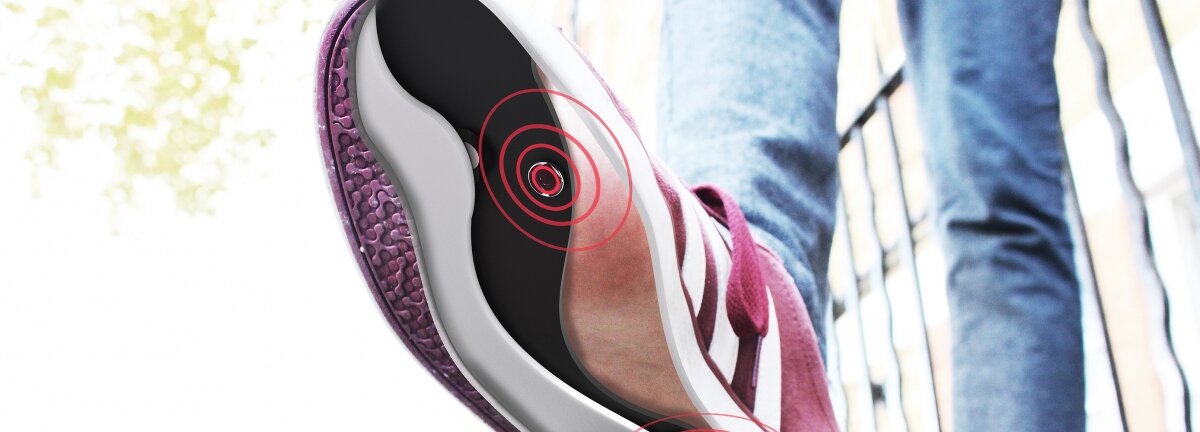Paving the way for confident walking: the story of Walk with Path

Walk with Path is one of 10 startups currently taking part in the final stages of MedTechSouthEast: our accelerator programme offering fast tracked access into the NHS. Walk with Path's inventor Lise Pape will be documenting her experience of the programme and the impact it has on her business. In this first instalment, Lise discusses the inventions that she hopes will bring everyone to their feet.
The MedTechSouthEast programme excitingly began for us by being featured in the Evening Standard, a coup that resulted from the original pitching process. So we started on a positive note which is exactly how we mean to go on.
Best foot forward to improving mobility
Our two products, Path Feel and Path Finder were developed with a strong user focus on people with mobility disorders. The aim was to create products that can improve mobility and confidence when walking, while minimising the risk of falling. This can have positive consequences on people’s general wellbeing, both physical and social, such as increased independence and reduced social isolation.
It can also potentially lead to cost reductions for healthcare providers, such as the NHS, who spend close to £5m every single day on falls. These costs are expected to increase in future, and it is therefore paramount that something is done to prevent such events from occurring.
Path Finder
Path Finder aims to tackle 'freezing of gait’ (FoG) – a common challenge for people with Parkinson’s, who describe it as the feeling that their feet are glued to the floor. The symptom is one of the main causes of falls in people with Parkinson’s, and significantly affects their confidence in attempting to walk.
Simple visual cues such as lines on the floor to step over have been shown to improve mobility and reduce FoG, thought to be because they help the brain to visualise and focus on the act of walking.
Our solution is a pair of shoes with lasers at the front which project green lines ahead as the person walks, activated by a sensor in each heel that monitors the user’s walking pattern and pace. Early clinical trials have found users reported a decrease of up to 55% in time spent frozen compared to total walking time.
Path Feel
Path Feel is an insole that provides haptic (vibration) feedback to the user when walking. It uses these tactile cues to enhance sensory perception of the environment and help to trigger movement.
The insole has pressure sensors and bluetooth monitoring to collect data that can be made available to users and medical professionals. This could help to improve understanding of the debilitating condition for the individual, and more broadly across whole populations. These results will enable better quality of life for the wearer and can lead to a reduction in spend for healthcare providers.
Become a Path Feel study participant
One of our current studies involves healthy people who are testing if the Path Feel insole can influence how they walk. This study is in collaboration with Queen Mary’s University in London, who are conducting a range of exercises with test participants, which are measured to provide a before and after scenario. We hope to have the results from these tests early next year, and are currently looking for more study participants who are either a size UK 6 (women) or UK 9.5 (men). If you are interested in participating, please email me at: lise@walkwithpath.com
Our MedTechSouthEast progress
After progressing past the pitching stage of the MedTechSouthEast competition, we went to the two-day introduction workshop at Design Council. This was a very informative and well executed event. It was great to hear from experienced designers, who shared specific information about key projects they had worked on. One specific example that stood out for me illustrated research work carried out on the use of a light therapy product for babies used in hospitals. This, I thought, was an excellent example of a design-led creation based on user insights and observations.
The specific mentoring and planning was very useful for us to focus on the development of Path Finder, and set out some key exercises and focus groups that we can do with Parkinson’s sufferers. These will include work on the visual and aesthetic aspects of Path Finder, as well as user experience and functional optimisation. It will be important for us to make a product that can cater for different types of gait, ensure sufficient battery life between charges, and be used both indoors and outdoors, including in strong sunlight.
We're very excited about engaging with the MedTechSouthEast programme over the coming 10 weeks, I'll keep blogging to keep you up to date with our progress.
Subscribe to our newsletter
Want to keep up with the latest from the Design Council?
